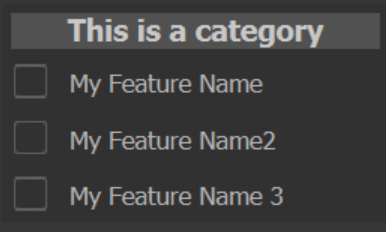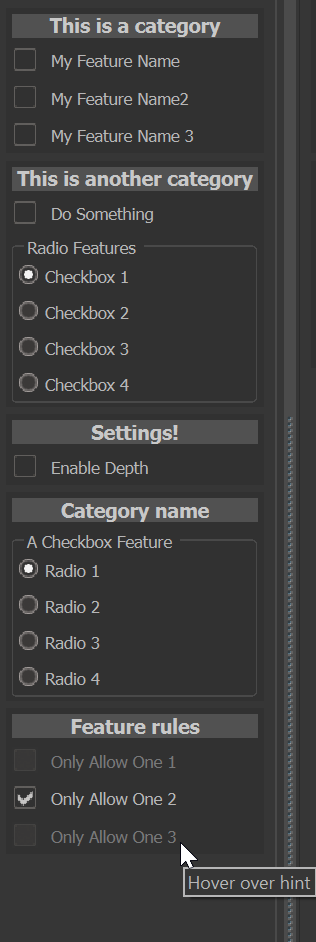Anatomy of Shader Files
What is a shader File?
The .shader file is a container for your shader program. Its main purpose is to eliminate the need for multiple shader files for each shader stage. The .shader file is a plain text file and it can be opened in any code/text editor and the underlying shader format is HLSL. The .shader is split into multiple different sections separated by a header and curly brackets. An example of the SHADER format can be seen below:
HEADER
The shader HEADER section gives information about the header and sets the compile targets. The following options can be set:
| Key | Value Type | Example | Explanation |
|---|---|---|---|
| Version | Number | Version = 1; |
Sets a version number for your shader, this is shown in the Material Editor |
| DevShader | Boolean | DevShader = true; |
If your shader is marked as a dev shader, you can reload your shader in the Material Editor |
| Description | String | Description = "My shaders description"; |
A description of your shader which is shown to the user in the material editor |
| DebugInfo | Boolean | DebugInfo = true; |
Ships debug information with your shader, this is only useful for developing shaders. Shipping shaders with this will drastically increase the file size |
FEATURES
Features allow you to add customization to your shaders in the form of using the shader preprocessor(note that this is different from the HLSL preprocessor). Features allow you to specify conditions on attributes, sampler settings, or render states. Features MUST be defined within the FEATURES section and feature names MUST start with F_!
Features have multiple different configurations and settings, you have regular checkboxes, radio buttons and rulesets to only allow one feature or the other. Features are defined as follows:
Feature(F_FEATURE_NAME, RANGE_MIN..RANGE_MAX, "Feature Category");
Checkbox
MY_FEATURE_NAME is transformed into My Feature Name. All underscores are converted into spaces within the material editor. The range 0..1 indicates that this is a checkbox. These checkboxes will also share the same category.

Categories
You can create another category by providing a different category name.

Radio buttons
Features also allow you to have radio buttons. A group of buttons that only allow one choice. This is done by specifying a range that is greater than 0..1 within the feature and providing the names of each radio button. It can be done as so:
Feature rules
Feature rules allow you to limit the section of options. It works similarly to radio buttons however it's a bit more fine control. Feature rules are defined as follows:
FeatureRule(RULE(F_FEATURE1, F_FEATURE2, ...), "A useful tooltip");
Below is a list of feature rules:
| Rule | Arguments | Example | Info |
|---|---|---|---|
| AllowN | F_FEATURE_0, F_FEATURE_N | FeatureRule(Allow1(F_FEATURE1, F_FEATURE2, F_FEATURE3), "You can only pick one!"); |
N is any number |
| RequiresN | Same as above | FeatureRule( Requires1( F_FEATURE_X, F_FEATURE_Y ), "You need to enable F_FEATURE_Y before using F_FEATURE_X!" ); |
N is any number |
Using features
As features are only run through the shader preprocessor, you can only use them in such things as within render states. An example of their usage can be used as below:
Example

Common
The common section is any information that is shared between all shader stages. This can include anything from defines, includes functions, etc. An example can be seen below:
Shader Inputs/Outputs
The shader inputs and outputs are structs that act like sections. If you noticed in the sample file, they are defined in the same area as headers are. There are multiple different inputs and outputs which you can use:
| Input/Output | Stage | Name | Alternate Name | Note |
|---|---|---|---|---|
| Input | Vertex | VertexInput | VS_INPUT | |
| Input | Pixel/Fragment | PixelInput | PS_INPUT | |
| Input | Geometry | GeometryInput | GS_INPUT | |
| Input | Geometry | HullInput | HS_INPUT | Deprecated |
| Input | Domain | DomainInput | DS_INPUT | Deprecated |
| Output | Vertex | VertexOutput | VS_OUTPUT | |
| Output | Pixel/Fragment | PixelOutput | PS_OUTPUT | |
| Output | Geometry | GeometryOutput | GS_OUTPUT | |
| Output | Geometry | HullOutput | HS_OUTPUT | Deprecated |
| Output | Domain | DomainOutput | DS_OUTPUT | Deprecated |
Example
Shader Stages
There is a section for each dedicated shader stage, the valid shader stages are as follows:
| Stage | Name | Entry Point | Notes |
|---|---|---|---|
| VS | Vertex Shader | MainVs | |
| PS | Pixel/Fragment Shader | MainPs | |
| GS | Geometry Shader | MainGs | |
| HS | Hull Shader | MainHs | Deprecated |
| DS | Domain Shader | MainDs | Deprecated |
| CS | Compute Shader | MainCs |
A shader can have as many unique stages as you like. Typically you'll be using PS and VS in most shaders.
 Garry's Mod
Garry's Mod
 Rust
Rust
 Steamworks
Steamworks
 Wiki Help
Wiki Help
 S&box
S&box